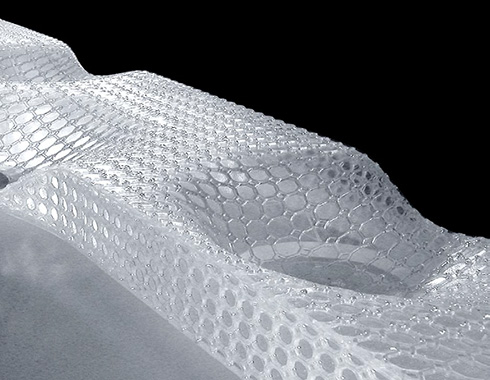
Located in extreme environmental conditions in the California mountains, ‘Ecoscape’ is a self-sufficient structure, constructed primarily of a roof skin made of two advanced technological systems: photovoltaic cells (BIPV) and Texlon Foil. These systems allow a fabrication of a morphed roof envelope determined according to the solar movement, the sun geographical position, sunlight intensity and beams of light reflection and refraction. The morphology was based on a repetition of prefabricated singular cell using methods of parametric and algorithmic design. This was in order to reach maximal exposure to the sun and a full integration between the structure and nature, while maintaining a cost-effective operation.
The amalgamation of the hyper-surfaced roof together with advanced ecological systems integrates natural conditions (heat, wind, ice) and the structure as modes of inhabitation. It does not attempt to integrate nature and habitation, but rather to instigate habitation as nature. By implementing advanced technologies, Ecoscape proposes a concept of architecture that is located discursively in-between culture and nature.
This concept does not distinguish architecture from nature. Nor does it suggest implementing Postmodernist operations of imitating nature artificially. Instead, Ecoscape proposes an operation in which architecture is based on naturalistic mechanisms, methodologies and procedures. In this operation, technology becomes nature.
Open Source Architecture is an international research practice dedicated to the production of dynamic and fluid architectural systems based on inclusive processes of data treatment and technological operators. Its explorative team – formed by Chandler Ahrens, Eran Neuman and Aaron Sprecher – undertakes experimental design with the aim to establish synergetic relations between architectural theory, design methods and technological research and design. Main emphasis is placed on investigating new modes of spatiality and materiality made available through the accelerated changes of contemporary culture, technological, natural and ecological conditions and attempts to assess their influence on architectural entities.